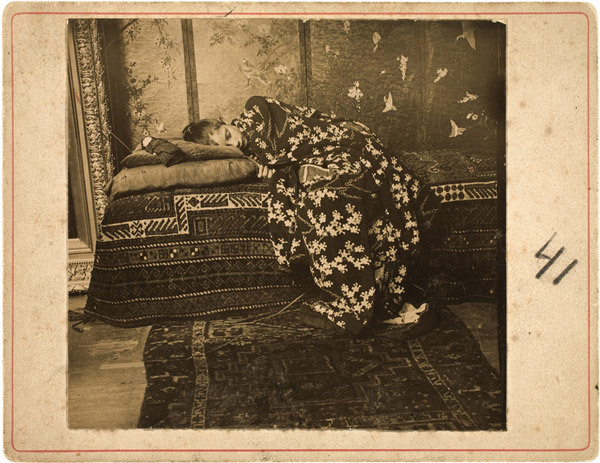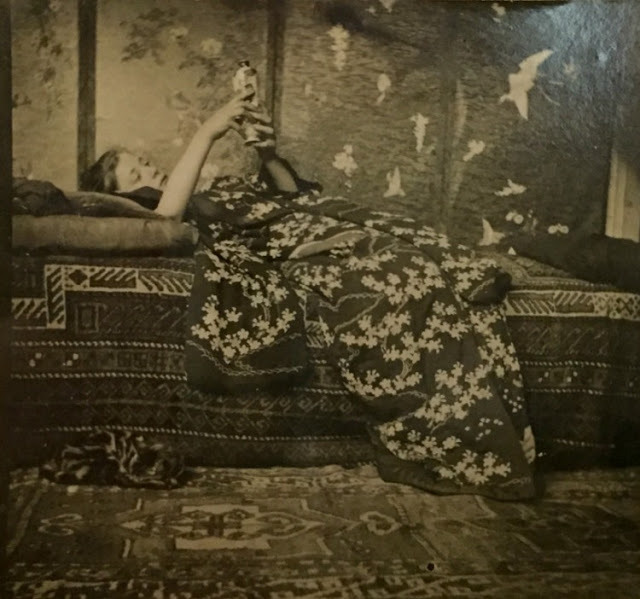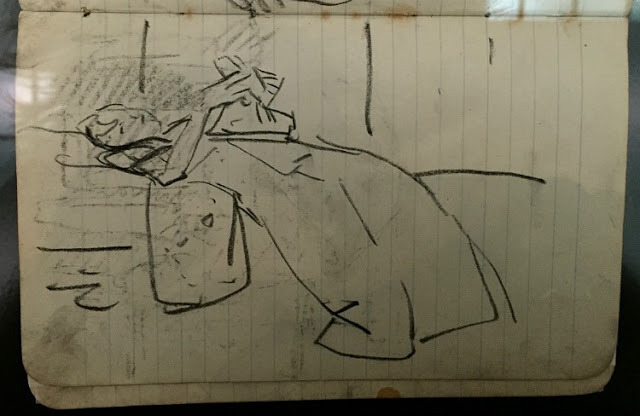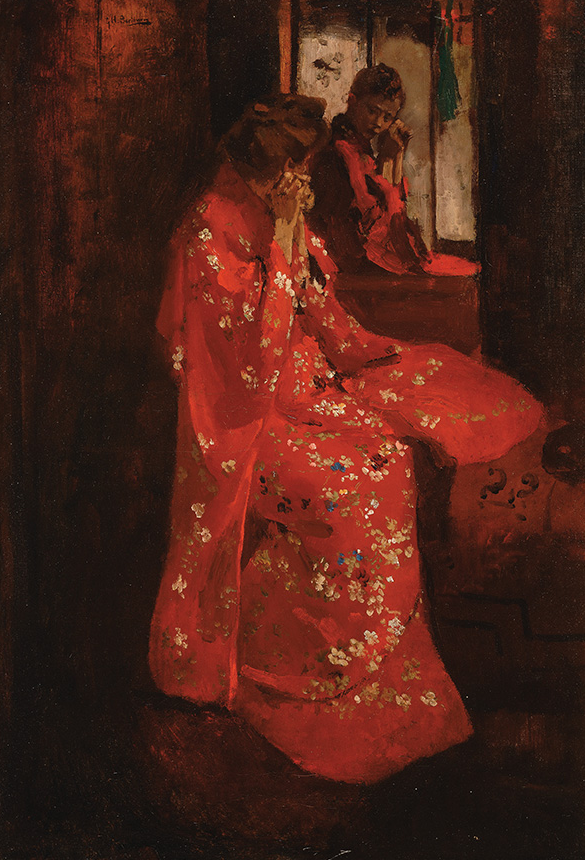The same thing happens to me this time of the year when the winter is giving way to spring, the first white blooming trees are looming one the horizon in the pinkish but still chill dusk. A certain rare disease whose symptoms are hard to explain suddenly overwhelms my body and soul, leaving me fatigued, dreamy and unable to think of anything else. The disease is called madness for Japonism. My heart aches for cherry blossoms, zen gardens, mystic temples, lanterns, kimono, the vibrancy and the serenity. Unable to fully cure this madness, I can alleviate the symptoms and the only way to do so is to gaze at Ukiyo-e prints and admire their wonderful strangeness and exoticism, soak myself in Whistler’s serene paintings in white and grey and listen to Debussy’s sonata for flute, viola and harp which instantly transports me to an exotic gardens, fragrant and serene where under moonlight the cherry blossoms spill all their naughty secrets to my ears.
 George Hendrik Breitner, Girl in Red Kimono, Geesje Kwak, 1893-95
George Hendrik Breitner, Girl in Red Kimono, Geesje Kwak, 1893-95
Before we properly start with the post, I want us all to take a moment to fully appreciate the gorgeous red colour that Breitner used without shyness on all of these paintings, whether it’s the case of a bold glimmering red kimono with white flower print, or a grey-white kimono with tiny red flowers which look like exploding red stars, so vivacious and so powerful. The red colour on any canvas just transforms things for me, takes them on an entirely new level. It just has a mesmerising effect on me, especially when I think of the delightful contrast between the passionate bold red and the delicate soft pink-white of the newly sprung blossoms.
The main model for all these lovely paintings was a working class sixteen year old girl called Geesje Kwak who had the luck and privilege to be transformed, at least in the artist’s studio and on the canvas, to a beauty from the far east, dressed in fine soft silks and holding a Japanese doll in her hands. This series of Japonism paintings by a Dutch painter George Hendrik Breitner is by far the most beautiful example of the portrayal of kimono in the nineteenth century western art. Breitner was nor the first nor the last painter who was inspired by Japanese art but he was a rare one who focused not exclusively on , but solely on kimono, the vibrancy and the patterns.

George Hendrik Breitner, Girl in a kimono (Geesje Kwak) in Breitner’s studio on Lauriersgracht, Amsterdam, 1893
After Japan started trading with the West in 1854, almost over night the Western market was flooded with Japanese woodcut prints known as Ukiyo-e prints. These vibrant, strange and exotic woodcuts were something completely new to the western eyes and soon enough Japonism became all the rage in the artistic circles and this influence didn’t decrease as decades passed but only grew stronger and even influenced the early twentieth century art movements such as Art Nouveau. The Impressionists were the first group of artists to create works inspired by the far east. Artists such as Edgar Degas, Edouard Manet, Whistler, Vincent van Gogh and Gauguin were all inspired by some aspect of Ukiyo-e prints, whether it’s the perspective, the flatness or the motif.
Breitner, who was acquainted with Japonism during his visit to Paris in 1882, and then again in 1892 he visited the exhibition of Japanese art in the Hague, used a more obvious motif taken from the Japanese art: on more than a dozen canvases in this series he explored the kimono, something that all the ladies in the Ukiyo-e prints are seen wearing. The folds and the shimmer of the silk, the vibrant colours and wild prints all made the kimono an eye-catching and interesting motif to paint. Whistler painted his models in loose kimono-style garments and Monet bought a kimono for his young wife and painted her wearing it in 1876. After the wave of Japonism madness swept him too, Breitner bought a few folding screens and a few pretty kimonos. Now he only needed a delicate flower for a model to wear them and pose for him, and Geesje was in the right place at the right time.
 George Hendrik Breitner Girl in Red Kimono Geesje Kwak, 1894
George Hendrik Breitner Girl in Red Kimono Geesje Kwak, 1894

Geesje Kwak. Study for ‘The red kimono’, Photo by Breitner, 1893

George Hendrik Breitner, Sketch for ‘The red kimono’, 1893-95, picture found here.
Little is known about Geesje and we can assume that this mysterious girl would have been forgotten by history if she wasn’t posing for Breitner. She was born as Gezina Kwak in Zaandam on 17 April 1877 and moved to Amsterdam in 1893. She worked either as a seamstress or as a salesgirl in a hat shop. In a right place at a right time, Geesje moved to the street where Breitner’s studio was and soon started modelling for him regularly. Their relationship was strictly professional and Breitner noted down in his notebook the precise hours and duration of her sittings. Before Breitner’s Japanese phase, his passion was the portrayal of the underbelly, the poor and the miserable, and the fact that Geesje was a simple, working class girl appealed to his sense of social awareness. Geesje’s sister Anna also posed for Breitner and you can see her in resplendent red kimono down bellow, but Geesje was the main model.
Geesje would walk around the studio, as in a zen garden, or lounged on the divan, sit in front of the mirror, and Breitner sketched her and even photographed her. It’s a good thing he did because in 1895 Geesje and her sister moved to South Africa where Geesje died in 1899 from tuberculosis at the age of twenty-two. Beauty tinged with sadness is how I see all the gorgeous paintings. The blossoms of spring, cherry, plum or apple blossoms, are delicate and ephemeral, better gaze at them before they vanish, better paint them before they wither. And I feel the same could be said about Geesje, looking at her life in retrospective; it’s a great thing that Breitner painted her while she was alive and captured her delicate beauty in those gorgeous kimono.

George Hendrik Breitner, Girl in Red Kimono in Front of a Mirror, 1894
George Hendrik Breitner, Girl in a White Kimono, c 1894-95

George Hendrik Breitner, Anna (Girl in a Red Kimono), 1894
.jpg)
George Hendrik Breitner, Girl in a white kimono (Geesje Kwak), 1893

George Hendrik Breitner, Girl in a White Kimono, 1894



This is such a lovely series! There was a beautiful exhibition dedicated to this series in the Rijksmuseum as few years ago. I remember Geesje’s sad story from there. The colors of the paintings are very inspiring. Thanks for reminding me to put the postcards I got up somewhere 😊
LikeLiked by 1 person
Oh lucky you, to have seen the exhibition! Yes, you should put the postcards somewhere to inspire you with the uplifting colour 🙂
LikeLiked by 1 person
Yes! I had them in my old apartment in Amsterdam, where they fitted really well because the house was also from around 1900. Now I live in a house in Finland built in the 60’s. I’m still figuring out what fits best here. But I’m sure I’ll find a good spot for the postcards 😊
LikeLiked by 1 person
I have a wall above my bed filled with pretty pictures, flowers, rock stars, art, and it really inspires me on a daily basis. I am certain that colours can bring joy to our psyche 🙂
LikeLiked by 1 person
Most definitely!
LikeLiked by 1 person
Stunning paintings and a wonderful story. You have shown me an artist and model I’ve not known. What a short life for the girl. Sad indeed.
LikeLiked by 1 person
Thank you! I’m glad you enjoyed reading it 🙂
LikeLike